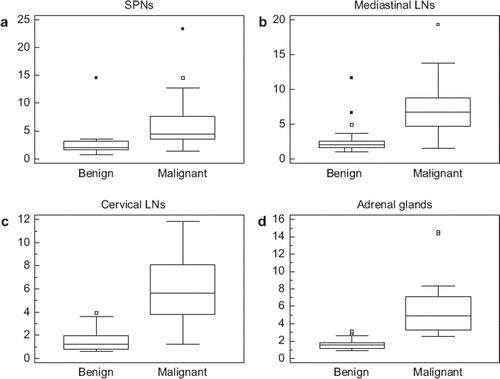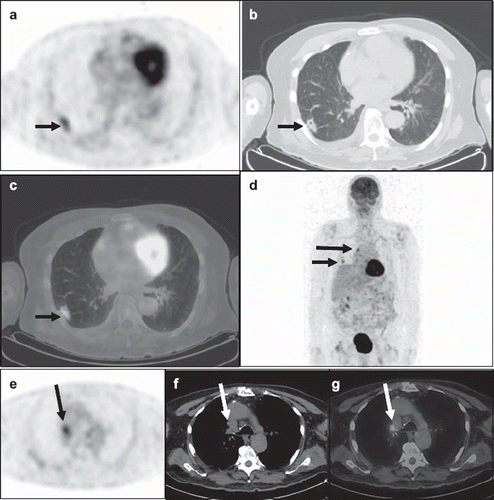Figures & data
Table I. Summary of the distribution of benign and malignant lesions in the four subgroups. Data are numbers (%) of patients and on a patient-by-patient basis unless otherwise indicated.
Figure 1. Box-and-whisker plots of SUVmax of SPN, a: mediastinal LNs, b: cervival LNs, c: and adrenal glands, d: Closed dots represent mild outliers. The frequency of extreme outliers shown as open dots is seen only in SPNs and mediastinal LNs and is absent in cervical LNs and adrenal glands. Moreover, SUVmax between benign and malignant lesions of SNPs and mediastinal LNs overlap more than in those of cervical LNs and adrenal glands. As a result, SUVmax thresholds are positively skewed for SPNs and mediastinal LNs. Data are on a patient-by-patient basis except the adrenal glands which are on a lesion-by-lesion basis.

Table II. Summary of lesion size and SUVmax characteristics in the four subgroups. Data for lesion size and SUVmax are median (minimum-maximum) and on a patient-by-patient basis unless otherwise indicated.
Figure 2. A 71-year-old man was admitted with delirium and fever. An MRI of the brain with and without contrast showed subacute ischemic of the left posterior frontal and parietal lobes. Blood cultures, lumbar puncture and bronchoalveolar lavage were negative for infectious pathogens. Diagnostic CT of the chest showed a right lower lung lobe nodule and an enlarged right tracheobronchial lymph node for which the FDG PET/CT was ordered for further evaluation. Axial PET (a), CT (b) and fused PET/CT (c) images demonstrated a spiculated 2.5 × 1.2 cm right lower lung lobe nodule with prominent FDG uptake (SUVmax 3.8), short arrow. This lesion (short arrow) was seen in the maximum-intensity-projection (MIP) image (d), which also showed a hypermetabolic focus in the right tracheobronchial region (long arrow). Axial PET (e), CT (f) and fused PET/CT (g) demonstrated an intensely hypermetabolic (SUVmax 4.2) right tracheobronchial lymph node measuring 1.7 × 1.5 cm in size (long arrow). The PET/CT findings were suspicious for lung primary with mediastinal metastasis. Subsequent core biopsy of the right lung nodule revealed granulomatous disease with abundant yeasts. Following antifungal treatment, the patient was afebrile on 3-month follow-up, and the right lung nodule and mediastinal lymph node resolved on chest CT.

Table III. Summary of SUVmax thresholds and corresponding sensitivities, specificities, positive predictive values (PPV), negative predictive values (NPV) as well as AUC for the four subgroups. Data are on a patient-by-patient basis unless otherwise indicated.